

AvoidingDeNaturedScience. Michael Shermer: Why people believe strange things. What's Wrong With the Scientific Method? My version of the scientific method Open a middle-school textbook or look on the wall of a science classroom.
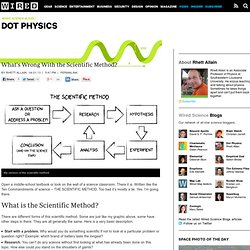
There it is. Written like the Ten Commandments of science – THE SCIENTIFIC METHOD. Too bad it’s mostly a lie. Yes. What is the Scientific Method? There are different forms of this scientific method. Start with a problem. Yes. Let’s just look at a few examples of science projects that don’t fit the above method. In 1928 Alexander Fleming accidentally left a cover off a petri dish used to cultivate bacteria. The point I am trying to make is that there are many cases that don’t quite fit this universal scientific method. Where Did This Scientific Method Come From? Chapter 1: The Nature of Science. Chapter 1: THE NATURE OF SCIENCE Over the course of human history, people have developed many interconnected and validated ideas about the physical, biological, psychological, and social worlds.
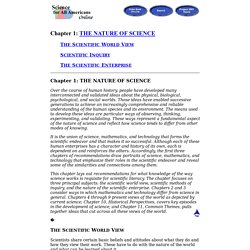
Those ideas have enabled successive generations to achieve an increasingly comprehensive and reliable understanding of the human species and its environment. The means used to develop these ideas are particular ways of observing, thinking, experimenting, and validating. Understanding Science: An overview. To understand what science is, just look around you.
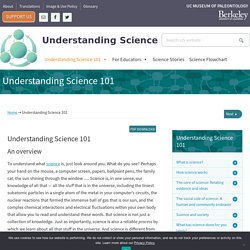
What do you see? Perhaps, your hand on the mouse, a computer screen, papers, ballpoint pens, the family cat, the sun shining through the window …. THE PRINCIPAL ELEMENTS OF THE NATURE OF SCIENCE: DISPELLING THE MYTHS. Designing Experiments Using the Scientific Method. How do the scientists know what they know?
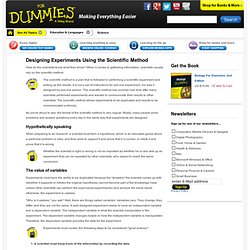
When it comes to gathering information, scientists usually rely on the scientific method. The scientific method is a plan that is followed in performing a scientific experiment and writing up the results. It is not a set of instructions for just one experiment, nor was it designed by just one person. The scientific method has evolved over time after many scientists performed experiments and wanted to communicate their results to other scientists. The scientific method allows experiments to be duplicated and results to be communicated uniformly. Nature of Science. ENSI/SENSI: Evolution/Nat.of Sci.Home Page. 19 February 2017 ATTENTION, FILMMAKERS!

A chance to make a film about evolution and win a prize! Scientists and science educators of all stripes -- students, postdocs, faculty, and full- or part-time science communicators -- are invited to enter the Seventh Annual Evolution Video Competition, sponsored by the Duke Initiative for Science & Society, the Howard Hughes Medical Institute, the Society for the Study of Evolution, and the BEACON Center for the Study of Evolution in Action. To enter, please submit a video that explains a fun fact, key concept, compelling question, or exciting area of evolution research in three minutes or less. Entries may be related or unrelated to your own research, and should be suitable for use in a classroom. The finalists will be screened at the Evolution 2017 meeting in Portland, Oregon.
Sciencelearn Hub. Exposing PseudoAstronomy. Introduction In preparation for a few public lectures I’ll be doing in the next 6 months, I wanted to address another one of the three main (that I’ve see) straight-forward young-earth Creationist claims about astronomy that “prove” we live in a young universe: Spiral galaxies “wind themselves up too fast.”
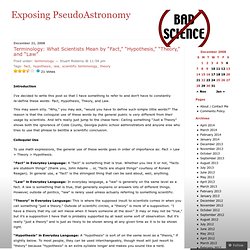
This is actually the #1 claim in Russ Humphrey’s treatise on “Evidence for a Young World” that you can find on sites such as Answers in Genesis or the Institute for Creation Research (e.g., this link). Note that the #2 reason presented is that comets would disintegrate too quickly (which I’ve addressed here) and the #5 claim (#3 astronomy claim) is that the Earth’s magnetic field is decaying too quickly, which I will address in a future blog post. About Spiral Galaxies Spiral galaxies, such as the one above (M101), are generally medium- to large-sized congregations of stars. The feature in question in creationist circles is these subjectively beautiful spiral arms themselves. Fact or Theory. Fact or Theory?
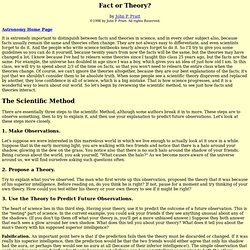
By John P. Pratt©1998 by John P. Pratt. All rights Reserved. Astronomy Home Page It is extremely important to distinguish between facts and theories in science, and in every other subject also, because facts usually remain the same and theories often change. What Science Can't Prove. If science can't even disprove the existence of unicorns, how can it disprove the existence of God?
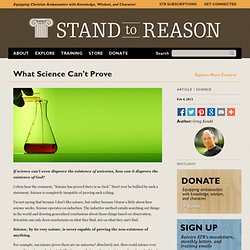
I often hear the comment, "Science has proved there is no God. " Don't ever be bullied by such a statement. Science is completely incapable of proving such a thing. I'm not saying that because I don't like science, but rather because I know a little about how science works. Science operates on induction. Science, by its very nature, is never capable of proving the non-existence of anything.